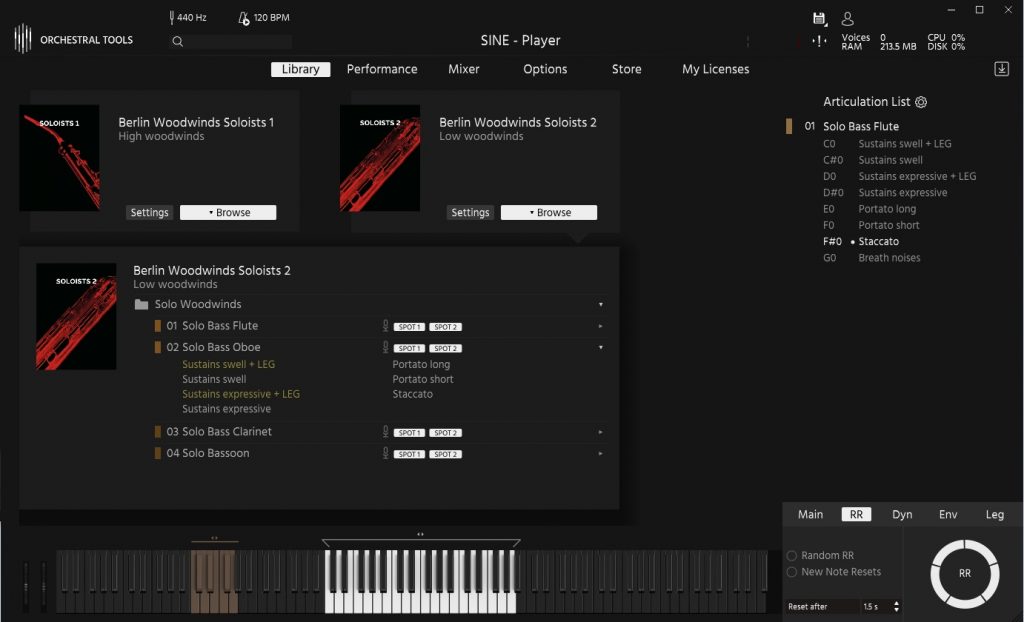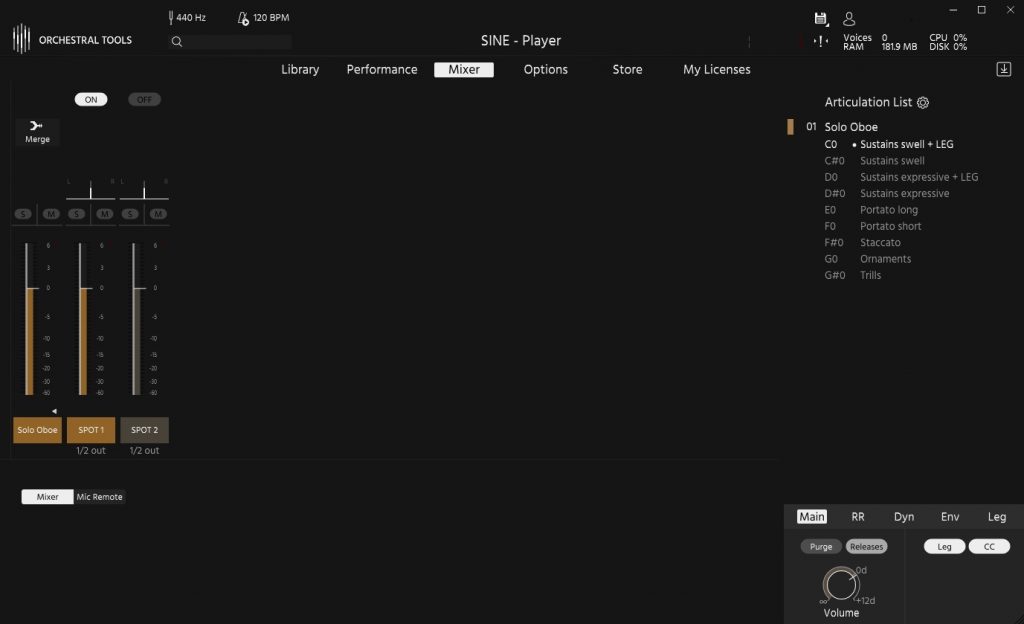Today we have the pleasure to review the Berlin Woodwinds Soloists bundle. This new bundle includes the two former Berlin Woodwinds Expansions B & C, now known as Berlin Woodwinds Soloists 1 & 2. Orchestral Tools recently ported them to their own SINE player format.
We were kindly provided with a copy to check Berlin Woodwinds Soloists out.
OVERVIEW
Berlin Woodwinds Soloists 1 & 2 features nine solo instruments: a flute, an alto flute, an oboe, an English horn, a clarinet, a bass flute, a bass oboe, a bass clarinet, and a bassoon. Contrary to the main Berlin Woodwinds library which was captured at the Teldex scoring stage, all the soloists here were recorded in the Teldex Solo Booth. This results in very dry-sounding recordings that allow for maximum spatial flexibility. For each woodwind instrument, we get to choose from two spot microphone positions. It is good to note that although these two libraries were released as expansions to the flagship Berlin Woodwinds, they can just as well be used as solid standalone instruments.
The two libraries mainly focus on expressive, lyrical playing techniques to perform exposed passages in an authentic way. Here is a quick overview of the patches included:
- Sustains (crescendo and decrescendo)
- Legato
- Portato (long and short)
- Staccato
- Trills (half-tone and whole-tone)
- Ornaments (half-tone and whole-tone, up and down)
- Breath noises
SINE PLAYER
In line with their plan to convert their product catalog to their own player format, Orchestral Tools now offers the Berlin Woodwinds Soloists 1 & 2 as SINE libraries. As with their previous SINE releases, this gives composers the ability to purchase individual instruments of a product separately, or to download different parts of the libraries à la carte. This is a huge advantage for customers wanting to stagger their purchases over time for example.
Just as with the other SINE releases, the same features, inherited from OT’s CAPSULE Player, are also present in Berlin Woodwinds Soloists. Out of these, some of the most notable ones include allowing users to apply legato transitions to all articulations, excluding particular round-robins if needed, and morphing two articulations together by using the cool Polymapping function.
ARTICULATIONS AND SOUND
Berlin Woodwinds Soloists 1 & 2 includes seven articulations across all sections, although some instruments have an added Trill, Ornaments, or even “Breath noise” articulation. All the articulations are recorded in just a single mf dynamic layer.

There are two things we can immediately notice as we play through the patches. The first one is that the samples are extremely dry. As the players were recorded in the Teldex Solo Booth, there literally isn’t any sense room, no audible tail. This is of course a conscious choice so that composers are free to choose which reverb they want to apply. This makes the libraries as versatile as possible.
The second thing we notice is how lyrical the patches are. The library has been designed to be used for expressive and exposed musical statements, and we can happily say it delivers on this front. A usual problem for solo libraries used this way is a noticeable phasing effect. To avoid this, Orchestral Tools chose to record a single dynamic layer that would fit most lyrical works (mezzo-forte/mf), and to add pre-recorded crescendo/decrescendo articulations as well as filters to mimic neighbouring dynamics if needed. This works quite well and as an added bonus, allows composers to get an authentic result without even needing to spend much time on MIDI CC programming. The recordings are already filled with natural emotions and dynamic movement.
The legato transitions sound particularly smooth, too. Some instruments even have different legato techniques, such as slurred, re-tongued, or agile. Benefiting from the SINE capabilities, composers can then assign these to two distinct speed zones so the corresponding technique will trigger depending on the playing speed. This yields added flexibility when compared to the former Kontakt versions.
Some of the instruments also come with a choice of vibrato and non-vibrato sustains. One such example is the clarinet. The non-vib sustain fits a typical classical context very well, while the vibrato sustain is well-suited for more emotional applications which could be useful for broader media use.
For more authentic phrasing and punctuation, some instruments also include ornaments (grace notes) and breath noises, which add another layer of realism. Interestingly, the Breath noises are not available for every instrument, but luckily they sound universal enough to be used with all of them in practice.

In terms of short articulations, the choice offered here is in line with the lyrical goals of the two libraries. All of these offer between 3 to 8 round robins.
In regard to sound quality, Berlin Soloists 1 & 2 clearly shines in exposed orchestral passages and does so quite effortlessly.
MICROPHONES
There are two spot microphones included in the Berlin Woodwinds Soloists. Given the recording location, both microphones offer an extremely dry sound with different tones. Spot 2 seems to give a bit of a rounder, tamer, and warmer sound. Spot 1, on the other hand, seems to be able to cut through mixes more easily. The Kontakt version of these libraries includes a Teldex IR that you can apply to taste. Unfortunately, the SINE version does not include such an impulse response yet. However, Orchestral Tools already hinted at the possibility to add this feature soon.

CONCLUSION
With Berlin Woodwinds Soloists, Orchestral Tools delivers a killer bundle of two of their acclaimed solo libraries. The conversion to SINE makes these two solid libraries even better and gives them a couple of new functionalities, along with a more consistent patch organization.
This makes them good candidates for composers who are looking for solo woodwind libraries that are capable of sounding convincing in exposed contexts and feel authentic even with little programming effort.
And once again with SINE, the fact that these instruments are available as separate sections, represents another big advantage in terms of purchasing options.
Pros
- Expressive and lyrical tone
- Great ease of use yields fast and convincing results
- The SINE port adds new functions and a better patch structure
Cons
- No Teldex impulse response included (for now)
RECOMMENDED: 9/10
Berlin Woodwinds Soloists is available as a download through Orchestral Tools’ online shop for €299. For comparison, when bought individually, the two libraries sell for €460 total.


0 comments on “Orchestral Tools – Berlin Woodwinds Soloists (Review)”